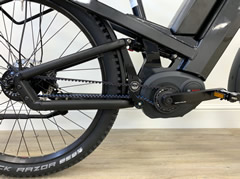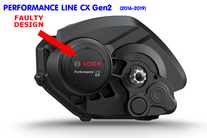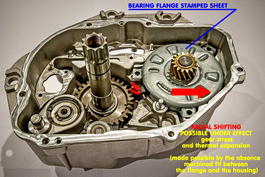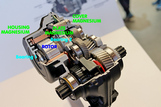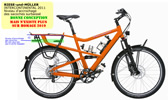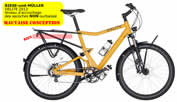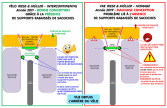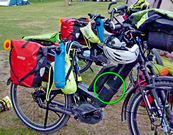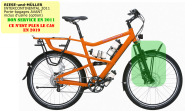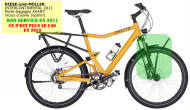


| < - > Bike — Sitting — Be heard — Push-back — Shield-oneself — Transport — Trailer — GPS — Drink — Camping — Energy |
| . . . Conventional Bike (Quality) — E.Bike Quality) 2019 — E.Bike Quality) 2024 — Gearbox ROHLOFF — BOSCH motor |
E.BIKE for CYCLO-HIKING - E.Bike R&M HOMAGE 2019 TEST
Here is feedback on the use of the HOMAGE e-bikes (2019 models) from Riese & Müller, with which we cycled from 2019 to 2022.
On page What-bike-in-cyclo-hiking? we reviewed the criteria for choosing the type of bike and the main technologies. We explained why we switched to E.Bike sooner than we thought.
SPOILER ALERT - 2023
In the year 2023 we discovered that the BOSCH PERFORMANCE LINE CX GENERATION 2 engines (which fitted our VAEs) had a completely unacceptable design defect. See below the chapter BOSCH MOTOR PROBLEMS
OUR CHOICE
Our previous bikes were RIESE & MÜLLER Classic Bikes. This German manufacturer has totally switched to the world of E-Bikes in 2014. So and considering our total satisfaction with these previous bikes, the obvious thing for us was to remain faithful to them. And therefore to search if we could find in their current range a model adapted to our bike tours.
In all cases we wanted to find the previous winning technology choices:
- All air-suspended
- Hydraulic disc brakes
- ROHLOFF transmission
At first glance a suitable model could be the DELITE. But the frame span height was a little higher than our current bikes. In order for these bikes to last us for a long time, we need to be able to continue to straddle them in the years to come by losing a little body's flexibility!
So the really appropriate model jumped out at us: the HOMAGE. And, transmission obliges, it is thus the HOMAGE GX ROHLOFF that caught our attention.
After favourable analysis of all its features, we analyzed all the tests published on the Web. Then we searched for a store. The dealer found had no HOMAGE in stock or demo, but they had NEVO and CHARGER. The objective of our test being to try the BOSCH engine, it suited us perfectly.
Convinced, we placed an order for delivery in early 2019.
RIESE & MÜLLER - HOMAGE GX ROHLOFF
The standard composition of these bikes is as follows:
- Engine: BOSCH Performance LINE CX Gen2 (FAILED)
- Dual-battery:
- One battery IN the frame: BOSCH PowerTube 500
- Another battery ON the frame: BOSCH PowerPack 500
- Display BOSCH Intuvia
- Fork SUNTOUR Aion 34
- Shock absorber X-FUSION O2
- Gearbox ROHLOFF Speedhub E14, 14-speed (see special page )
- Carbon belt drive GATES belt drive CDX
- Brakes MAGURA MT4
- Tires SCHWALBE Rock Razor 60-584
- Lights SUPERNOVA M99 Mini Pro-25
Dealer had replaced for us:
- The display BOSCH Intuvia with a BOSCH Kiox, more efficient and above all, advantage for us, more compact in width.
- The stem with an adjustable stem
- The tires SCHWALBE Rock Razor with SCHWALBE Marathon-Plus-MTB 57-584 (27.5" x 2.25", 650B), much more resistant, because from the puncture-proof flat-less range.
DETAILS OF SOME COMPONENTS
- The total power of the batteries amounts to 1,000 W (2 x 500 W) allowing a very good autonomy, even when heavily loaded.
- No chain, but a toothed belt. Guaranteed maintenance-free during cyclo-hiking.
- ROHLOFF electrically operated. No more cable twist grip, but a double knob on the handlebar.
- Dual-function lamp low-high beam (like a car) with handlebar control.
- Tail light with brake light, controlled by the 2 brake handles.
- Wheels 27,5"
ADDITIONAL ITEMS
We've added to it:
- Real horn instead of the cheap original buzzer
- Airzound 3, air horn (see page be heard)
- USB recharged electric horn.
- Our usual comfortable ISM TOURING saddles. A specific page is dedicated to this essential piece… Sitting - Saddle.
- Front luggage rack FAIV.
EXPERIENCE - QUALITIES - DEFAULTS
As explained in the introduction we have been RIESE & MÜLLER fans since our first purchase in 2012. With our old INTERCONTINENTAL AND DELITE classic bikes we have never stopped praising them all the time and everywhere for their fantastic qualities. Our page dedicaced to these model is an example of this. Our satisfaction with the use has been total and without limit.
We have therefore confidently switched to E.Bike mode with RIESE & MÜLLER. We have approached our GX ROHLOFF HOMAGE with totally favourable and benevolent a priori.
QUALITIES
As soon as my HOMAGE was delivered I was able to take advantage of its important fundamental qualities. Then my Darling was able to accompany me and we enjoyed everything together:
- Even more comfort than our old bikes. Larger wheel diameters and tires are a must!
- An even tastier ROHLOFF with its electric drive. It was a marvel. Now, it's a super marvel.
- MAGURA braking at its best. Less powerful on the attack than our old Shimano brakes (Deore XT M775); but in fact more progressive and with as much power in the end.
- Discover the qualities of the BOSCH motorization with its electronic regulation at the top and its 4 levels allowing to adapt to the desires of the moment and to the reliefs which arise.
With our pre-summer hikes, on a total of 3 to 400 km, everything went perfectly. The joy of riding RIESE & MÜLLER bikes continued in E.Bike mode.
Then our 2 hikes in the summer of 2019 (837 and 1,140 km) allowed us to confirm the first qualities described above. Moreover they made our doubts about the autonomy announced by BOSCH totally disappear. The mileage announced at full load are there. You can really trust their Range Assistant.
While driving around, unloaded with luggage, you can drive in ECO mode at 22 km/h :
- 240 km, with isolated coastlines, on poor quality roads and moderate winds
- 187 km, with hilly terrain, on a dirt road and moderate wind
- 148 km, with medium mountains, on dirt road and strong wind
- 97 km, with mountain trails, dirt roads and strong winds
Heavily loaded in cyclo-camping hiking, you can do in TOUR mode at 22 km/h :
- 160 km, with isolated coastlines, on poor quality roads and moderate wind.
- 123 km, with hilly terrain, on a dirt road and moderate wind
- 97 km, with medium mountains, on dirt road and strong wind
- 82 km, with mountain trails, dirt roads and strong winds
With the FAST-CHARGER BCS250 of 6 Amperes the recharge takes 3 hours to go from 0 to 100%. That is to say 3 hours to recharge the 2 batteries which are 50% discharged. It is very fast!
These bikes are therefore VERY FRIENDLY and VERY PERFORMING.
However, several dark clouds appeared in this idyllic picture.
BOSCH ENGINE PROBLEMS – DESIGN DEFECT
2019, ENGINE PROBLEM ON BOTH BIKES
2021, ENGINE PROBLEM ON BOTH BIKES
2022, ENGINE PROBLEM ON A BIKE
2023, ENGINE PROBLEM ON BOTH BIKES…
EPISODE 1 - 2019 - 2 engines changed
During the summer of 2019 we completed two hikes, the first of which was 837 km.
From the second day the engine of my VAE (PERFORMANCE LINE CX Gen2) began to emit strange noises occasionally. There was like a hoarse cicada in the engine. Distorted screams were emitted when pressing the pedals, i.e. when the assistance was active. As the days went by this became more and more frequent, until it became almost permanent.
Then my darling’s VAE did the same. So we came back very disappointed and immediately went to our bike shop with our bikes. Nothing happened on site. No shout-scream! I immediately understood why… not enough weight on the bike. Returned to the bike shop with 4 bags fully loaded with ballast... the test was immediately conclusive... the cicadas were still in the engines. We had to have a weight close to that which we had in cyclo-camping mode.
So return the motors to BOSCH for immediate replacement under warranty. But unfortunately BOSCH managed without telling our bike specialist anything about the origin of the problem, no explanation, no diagnosis. So I questioned them by email. They said, “Your 2 motors were replaced due to bearing issues. We confirm that this is not a defective series. ". Whose act!
We set off again, still loaded, for our second summer hike (1,140 km).
EPISODE 2 - 2021 - 2 engines changed
In 2020 we did 2 hikes (885 + 1,689 = 2,574 km) without problems.
On the other hand, in 2021 the problems returned with a vengeance:
- Even before our summer hike, my engine made terrible noises from time to time, much worse than in 2019. When this happened we were too close to our departure, so we left without technical intervention.
- During our hike, after 900 km, my Chérie's engine suddenly gave up the ghost: NO MORE MOTOR DRIVE.
We had to stop our hike (fortunately in France) and return home.
The 2 PERFORMANCE LINE CX engines were changed under warranty by BOSCH by the bicycle dealer:
- Mine because of the infernal noises that I had recorded with my Smartphone when it happened.
- That of my wife who was without training. In fact the output shaft splines had been completely trimmed!!! So no more drive of the belt crown. Unfortunately no explanation was provided by BOSCH.
Ten days later we left again and finished our hike (another 1,100 km).
EPISODE 3 - 2022 - 1 engine changed
During our 2022 hike, arriving on the Baltic Sea in northern Germany, my Chérie's engine broke again: NO MORE TRAINING. Premature end of the hike and return to France.
Support by the bicycle dealer confirmed exactly the same problem as in 2021: completely trimmed output shaft splines.
Terrified by this double problem, I insisted on being present during the dismantling. I then had in my hand the famous crown which was no longer driven. It is a stainless steel crown. It is from the GATES brand, which is the manufacturer of the transmission belt. This is a 83802 CDX Gates Carbon Drive. It had very small burrs on the teeth fitting onto the motor output shaft. So I wanted to have it changed for safety. The lead times (after COVID) for spare parts were still very long in the fall of 2022, my bike retailer's wholesalers announced lead times of several months. So I got this piece in Germany in a few days. And the bike specialist was able to reassemble everything, new engine and new crown, very quickly.
But what about the origin of this DOUBLE disruption in training (2021 and 2022)? Is this a recurring BOSCH defect on the output shafts of PERFORMANCE LINE CX (aluminum quality problem, machining defect, poor sizing)? Are these the micro-burrs on the stainless steel of the GATES crown? Alas, and in the end the unknown remains as to the origin since BOSCH remained silent…
…but their silence was accompanied by the billing of the engine.
EPISODE 4 – 2023 – 2 MORE ENGINES NEED TO BE CHANGED…
At the end of spring 2023, during a regional walk, problems return! My engine again made high-pitched screeching noises (plus grunts when simply pedaling along with no downforce) for dozens of miles. These noises were similar to those of past years, less terrible than those of 2021, but more significant than those of 2019.
Then at the start of summer (2023) we did a 2-day long walk. The first day (76 km) my engine made noises as terrible as in 2021. But the second day was incredible with not only the continuation of the noises, but arriving home (after 110 km covered in the day) the simply turning the crankset slowly with your hand caused enormous grunts and crackles with obvious jamming internal to the engine. This engine only had 4,043 km on it!
The (rotten!) icing on the cake: in this 110 km stage my Chérie’s bike started making “scream-scream” noises. Its engine changed at the end of 2022 only had 945 km! Re-belote on its almost new engine.
NO ! STOP! IT'S FINISH ! THIS IS UNACCEPTABLE
Until 2022 we could somehow believe the commercial talk about successive breakdowns. It was only stories of bad series, of accidental defects, of "bad luck", in short that everything would end up getting back to normal. But in this year 2023 we had SEVEN engines changed and we were going to have to do TWO more. Of course the guarantees were exhausted.
At this stage, and taking into account our careful use, it had definitely become obvious to us that there was a fundamental problem in the BOSCH PERFORMANCE LINE CX Gen2 engines. With each new problem our engines only had between 900 and 4,000 km on them. This situation would already have been unacceptable for ordinary e-bikes… but here we are on a very high-end level. So we said STOP! A RADICAL change was needed.
The problem was: how do we technically support our claim? It was therefore necessary to deeply analyze this cursed engine.
A happy circumstance occurred when changing the engine on my wife's bike at the end of 2022. Normally BOSCH only supplies a new engine in 2 cases: either as original equipment to a bicycle manufacturer, or to a repairer EN EXCHANGE OF A USED, UNOPENED ENGINE. By a fabulous coincidence the new engine was supplied by BOSCH without the old one being returned to them! So I had recovered this faulty engine… THE TIME HAD COME to dissect it.
I opened the engine and carefully studied its mechanics. In my analysis I relied on the audio and video recordings made when the problems appeared on our engines. By following the operating kinematics I was able to get to the heart of the problem of noises, grunts and jamming. The defect comes from the rotor. It is of course guided by 2 bearings. A first bearing is housed in a bore in the housing. On the other hand, the second is linked to a simple stamped sheet metal flange. And this flange does not have any precision machining for its insertion into the crankcase. In doing so, it has the possibility (under stress and temperature constraints) of shifting radially, causing premature wear of the 2 rotor bearings; and ultimately allowing friction of the rotor against the stator.
Unfortunately, knowledge of the problem has not spread on the Web because a certain number of criteria must be met for an VAE to suffer these damages. This limits the number of cases. This lack of knowledge makes users victims of this problem quite helpless since they are isolated.
First of all, this is limited to the most powerful engine in the BOSCH range: the PERFORMANCE LINE CX Gen2 (which is not the best-selling). Then special conditions are required:
- Driving heavily loaded is the case in cycle touring and especially, like us, in cycle camping.
In fact, the motor forces are then at the top of the range of use. And therefore the radial forces on the motor gears cause the greatest stresses on the rotor bearing flange. - Ride for a long time in a row. Most leisure cyclists and cycle hikers rarely exceed 40-50 km per day. While our local walks and cycle tours are 70 to 100 km long. In doing so, the thermal stresses are higher in the motor leading to the radial offset of the flange... and consequently the abnormal wear of the bearings... then, ultimately, the impact of the rotor on the stator.
All this is necessarily known to BOSCH. Even if the conditions for the occurrence of the problem restrict the number of cases, the fact remains that of the thousands of engines sold throughout the world, there have necessarily been a certain number of returns for these reasons...
And besides, this engine underwent a very big upgrade in 2020 (one year after purchasing our bikes):
- The PERFORMANCE LINE CX Gen2 [Generation 2] became PERFORMANCE LINE CX Gen4 [Generation 4] in 2020 (the Generation 3 don't exist).
- Performance (power, torque, etc.) has remained the same!
- But... the rotor is, SINCE THIS NEW IN 2020, perfectly guided by 2 bearings BOTH RIGIDLY ENCLOSED IN THE CASING!!!
Unfortunately, it is impossible to change our Gen2 engines with Gen4, the bike frames are incompatible! So to put a definitive end to our problems the one and only solution was to change our bikes for their strict current equivalent which have been equipped since 2020 with these famous Gen4.
Of course all the protagonists in this cycle sector innocently play pseudo-surprise. Hand on heart they all declare to you: " oh this is really the first time we've seen this ", then, when we insist, insidious comments arise " But what did you do with your bikes? ".
So we had to fight fiercely. It lasted a long time, our 2023 hikes were canceled. I produced a detailed and supported TECHNICAL REPORT to effectively defend the case. Thanks to this, and after many adventures, an amicable win-win agreement ended up being signed at the end of January 2024. And in March, 9 months after the start of the fight, 2 RIESE & MÜLLER HOMAGE Model 2024 bikes (Gen4 engine) brought us were delivered. Exit the 2019 models.
For those interested see the PAGE of the SIMPLIFIED VERSION OF MY TECHNICAL REPORT.
It is positive that an arrangement could be found, because otherwise the only solution was the legal route (we didn't get far!). And it would have been a shame not to continue to benefit from the remarkable qualities of these HOMAGE models from the excellent manufacturer RIESE & MÜLLER. These are exceptional materials. For cycling, they are the equivalent of high-end automobile SUVs (Sport-Utility-Vehicles).
The developments of these new frames (compared to our old ones from 2019) are detailed on the page HOMAGE-2024.
OTHER DEFAULTS - DESIGN DEFAULTS RIESE & MÜLLER
VERY FRAGILE BAG SPACER FLANGES
In the summer of 2019 our second ride took place in our cycling paradise: in Germany. One day we were at a stop for a break. Our bikes were resting on their crutches near a small embankment. A strong gale of storm wind knocked our bikes over. My Darling's bike lay on its side and fell on the embankment.
The bike was fully loaded with its 4 luggages bags. So there's no risk of any part of the bike hitting the ground. It's the luggages bags that serve as airbags, shock absorbers.
It wasn't a bad thing, it had happened several times on hard and flat ground with our old bikes since 2012. So we weren't worried. The angle of fall was low, because the slope was steep.
Except that the side flange of the luggage rack (the part that prevents the lower part of the bag from getting closer to the wheel) was DEFORMED. The side flange of the luggage rack (and thus the bag) was now closer to 4-5 cm from the wheel !!!
Huge and very unpleasant surprise. Why was there NEVER any problem with our old INTERCONTINENTAL or DELITE models, with harder falls? And that, there with a slight fall, it resulted in a permanent deformation on the HOMAGE.
It's actually quite simple. This is due to an incomprehensible design regression by RIESE & MÜLLER:
- The lateral flanges of our old classic bikes had double-cantilever:
- Top cantilever, with hard embedments on the luggage rack.
- Bottom cantilever, with sets of tierod joints between the lower lateral flange and the arm of the rear wheel.
- On all the new models there is NO cantilever (NO embedments, NO tierod joints).
- And the lateral flanges are content to be an unfortunate little tube that only wants to bend even more at the slightest constraint. And worst of all, the front part of this cheek tube ends with a crush-fold (#45°). Obviously this bending is an important deformation.
The error of absence of tierod joints is a failure to comply with the most basic level of mechanics, of the Theory of Strength of Materials:
Previously, with the tierod joints, the lateral flanges were supported up and down. Up on the luggage rack, down on the rear wheel arm. This arm being particularly rigid. This double cantilever support made that the flange was in flexural strength mode as "Beams Fixed at Both ends" (1 embedments at each end or 1 cantilever at each end).
Now, without the tierod joints, the lateral flanges only have a high support on the luggage rack. This simple support is defined in flexural strength mode as "beam fixed at one end" (1 embedded at one end or 1 cantilever at one end). The another end is free.
The resulting difference in deformation is enormous. And we prove it by calculation. Let's imagine that we can dismantle the tierod joints of the old Classic DELITE. And let's calculate the deformations in both cases, with and without tierod joints. Opposite, in picture, the mathematical formulas. And below their application:
- With 1 cantilever (without tierod joints) the formula is Y = - (F . L³) / (3 E . IGz)
- With 2 cantilever (with tierod joints) the formula is :
Y = - (F . L³) / (192 E . IGz)
When applying the formulas, the difference in length of the beam must be taken into account depending on the model with or without tierod joints: if L1 is the length in version 1 cantilever (without tierod joints), then L2 (version 2 cantilever with tierod joints) is approximately equal to 2 x L1.
Let L2=2xL1.
After simplification of the compared formulas, we obtain the deformation ratio which is (L/3) / (2L/192), i.e. 3/96.
The difference in deformation on a DELITE with or without tierod joints is therefore in the ratio of 3 to 96, i.e. 32 TIMES more important by removing the tierod joints.
And again, we have calculated here simply "with or without tierod joints", but in both cases with the same quality fittings. But on the HOMAGE it's much worse. The lateral flanges of the HOMAGE have almost no embedding (cf. crush-fold described above). So the deformations are much more important there.
But moreover on an old DELITE without tierod joints the deformation would have returned to zero, once the effort (linked to the fall) disappeared. But on the HOMAGE the stress exceeds the resistance capacity of the metal. The important deformation is permanent. In the Theory of Strength of Materials we call this "exceeding the elastic deformation limit" (where the object returns to its initial shape), and passing into the "plastic deformation zone", where the object remains deformed once the stress has disappeared.
In order to remove the tierod joints without too many negative effects it was necessary :
- Keep strong cantilever for the assembly of the lateral flange with the luggage rack.
- To enormously strengthen the tube forming the flange.
With such a reinforcement, it would have been less resistant than with tierod joints, but it would have been better than nothing.
But in the reality of HOMAGE:
- There is almost no embedments at the top at the junction of the luggage rack…
- The tube has not been reinforced, but rather lightened.
So the misery of the deformities was inevitable.
Even a trainee technician would be aware of the problem. Such an error on a first price bike would be abnormal enough. This is a German-made bike. Which is a reference, and rightly so. The quality in general and the mechanical know-how of Germany is not just an image. It is a reality which is at the base of Germany's industrial success. In addition RIESE & MÜLLER openly claims to be the most expensive, because the best (see its statements in the conclusion at the bottom of the page).
Has a decision-maker in aesthetics had the last word on all the most basic technical arguments?
If so, it would mean that RIESE & MÜLLER is taking the path to imitate Apple. With its computers, Apple is making machines that are more and more expensive… and more and more fragile. Always more fragile because they are always thinner and lighter to be always more finely aesthetic. It's already unreasonable for computers, but for off-road outdoor equipment, that would be aberrant !!!
Unfortunately we could not realize this critical point before placing the order, because the HOMAGE was not being tested at BIKE-CENTER.
In any case, whatever the reason, cost savings or aesthetics take precedence over functionality, it doesn't matter. On off-road bikes of this price it's indamistible and unbearable.
BAG HOOKING TOO HIGH
With bikes equipped with rear suspension the luggage rack is higher than normal. In fact, despite the suspension travel, the wheel must not hit the underside of the luggage rack. So the luggage rack is raised. This is detrimental to the static and dynamic balance of the bike, because luggage bags are hung very high, resulting in a higher overall center of gravity.
On my old RIESE & MÜLLER INTERCONTINENTAL classic bike (bought in 2012, but produced until 2011) my luggage rack was VERY well designed. There were horizontal bag hooking bars 80 mm lower than the luggage rack. Considering that the suspension travel and therefore the level of the luggage rack is 100 mm more higher, the level of carrying was going down to a very correct level.
On the other hand already at that time, there had been a regression for the RIESE & MÜLLER DELITE of my Darling (produced and bought in 2012). Indeed there were no more horizontal bars to hang the luggage bags. So the bags were very high. With a barycentre shifted upwards.
At that time our bikes were 26" wheel size. But in line with the new trend, our VAE 2019 bikes are equipped with 27.5" wheels.
And unfortunately, on our HOMAGE, RIESE & MÜLLER has maintained its regression initiated in 2012, no low grip of the bags. So, with the 27.5" wheels, we find ourselves with bags hanging even higher. They are raised by another 40 mm. Compared to the INTERCONTINENTAL (last well-designed model in 2011) the bags are 120 mm higher. This is enormous.
In addition to the too high center of gravity we have a second big disadvantage. This is that any load placed across the luggage rack (like a tent bag) weighs on the top of the luggage bags. So the bag hooks (which are only designed to support the bags) have to bear the weight of the bag across AND the pressure of the tensioners that hang the bag in question. All this is an abnormal overload of the bag hooks, with the risk of the hooks eventually breaking.
See the explanatory diagram opposite.
Historically RIESE & MÜLLER knew all these problems and knew how to solve them, but they don't do it anymore !!! Dark and aberrant economy? Aesthetics before functionality? What do they think?
BATTERY COVER PLATE SLAMMING
After about 1,000 km, during our German 2019 hike, a new noise appeared. At the slightest jolt, there was a constant rattling sound. This produced a very unpleasant pan noise!!!
In fact it was simply the cover for the Power-Tube battery located in the frame. This cover has a very small foam coating on the inside which is necessarily present to avoid this kind of noise.
But the problem is that this foam is very thin (too thin) and probably too soft. And since this plate has the second PowerPack battery on its back, it produces compressive forces by pressing in the middle of the closing plate. And the foam ends up compressing, and you get a pot show !!!
So far, the only solution to stop this mess has been to belt the frame and the plate in question with a tight Velcro strap.
This is not Deutsch-Qualitat at all!! What does Riese & Müller intend to do?
OTHER PARTS - PARTS FAULTS
By "Other parts" we mean what makes up the bike, what is assembled with it to finish the bike.
These are usually parts or accessories of other brands.
CHARGING PLUG SHUTTER
The shutter of the electrical charging plug is made of soft rubber. It opens easily. However, to close it again, you have to snap its lug into the connector and it is, each time, the head plug. The closing is only obtained after having groped for a certain time to insert the damned lug.
This is a very small detail, but it's very annoying… especially (once again) for a bike of this price.
FRONT LUGGAGE RACK
In 2012, when we bought our RIESE & MÜLLER INTERCONTINENTAL and DELITE, they were delivered from the factory (optional) with the very strong front luggage racks of their German colleague FAIV.DE. Which is a reference in quality front luggage racks for touring cyclists.
Now nothing is offered anymore, even as an option. Whereas this HOMAGE model, like its cousin the DELITE (E.Bike), are the most suitable E.Bike for cyclo-hiking in the current RIESE & MÜLLER range.
It's a shame we can't have a complete original bike anymore. It's a detail, but high quality service is also that!
CONCLUSION
Manufacturing defects leading to failure always exist in any production. Zero defects only exist for theory, only for what is NOT produced. However, breakdowns must remain rare... and borne by the manufacturer.
On the other hand, it is a shame that a manufacturer that claims to be high-end like RIESE & MÜLLER falls into design regression. That is to say when they knew how to do it correctly in the past, but they no longer do it. Mention is made here of the hanging of the rear panniers too high and the sides of the rear luggage rack which are very easily deformed; as explained earlier on this page.
Yes, these bikes have immense and undeniable qualities. They are even overall FANTASTIC, but… at the price we buy them we could have claimed to get totally perfect bikes.

